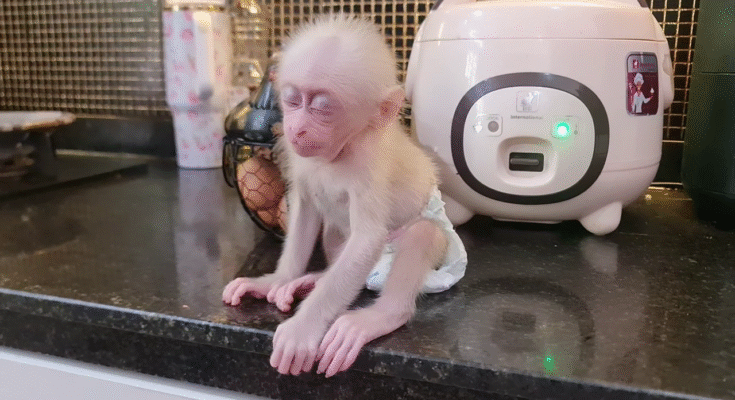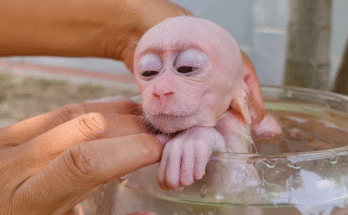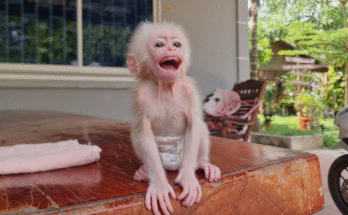The next morning came with a soft drizzle of rain. Tiny LuLu sat huddled under a thin piece of cloth. Her eyes blinked slowly, tired and unsure. The cold air made her fur damp, and her little fingers clutched her belly, hungry once again.
Before the milk arrived, LuLu always looked weak. She barely moved, her energy low from the long night. Her tiny face looked around, searching for a familiar sound — the steps of her caregiver. But the yard was still quiet.
A few birds chirped from the trees, but LuLu didn’t respond. She just sat still, waiting. Moments passed like hours until, finally, she heard the sound she had been hoping for. The woman came with the bottle, warm and full.
As the bottle touched her lips, LuLu closed her eyes. The milk was warm, sweet, and full of comfort. It filled her empty belly and warmed her heart. Her little hands gripped the bottle tightly, and her tail slowly swayed with relief.
LuLu wasn’t just fed — she was loved. And each morning before milk, though hard, always led to a moment of hope and care.
1. A Tong’s First Attempts: Overcoming Fear and Hesitation
At the start, A Tong was unsure about walking. Like all baby monkeys, he relied heavily on his mother for movement, often clinging to her for safety. However, as he observed other monkeys and felt the urge to explore, his curiosity pushed him forward. His first steps were wobbly, filled with hesitation, but each small effort helped him grow stronger. Through trial and error, A Tong gradually overcame his fear, proving that persistence is key to learning new skills.
2. Developing Balance and Coordination
Learning to walk isn’t just about moving forward; it requires balance and coordination. A Tong’s little legs had to develop the strength to support his body. At first, he stumbled frequently, often tumbling over soft grass or grabbing onto nearby objects for stability. His sharp reflexes helped him adapt quickly, and within days, he started moving with more control. Watching him adjust his movements and refine his balance step by step is truly an adorable sight.
3. The Role of His Mother and Social Environment
Like all baby monkeys, A Tong benefited greatly from his mother’s guidance. She stayed close, offering reassurance and protection. Her encouraging nudges and gentle grooming kept A Tong motivated to try again whenever he fell. Additionally, observing older monkeys walking and playing helped him learn faster. Social interaction plays a crucial role in the development of young monkeys, and A Tong’s journey is a perfect example of how baby monkeys grow by watching and mimicking their elders.
4. Building Strength and Confidence Through Play
Play is a vital part of A Tong’s development. As he gains confidence, he engages in playful activities like jumping, climbing, and running short distances. These playful moments not only strengthen his muscles but also sharpen his instincts. Whether he’s chasing after a leaf blowing in the wind or attempting to climb small branches, every playful movement contributes to his physical and mental growth. This playful nature is what makes baby monkeys so captivating to watch.
5. A Milestone Achievement: Walking Independently
After days of practice, A Tong finally takes confident, independent steps. His progress is an incredible milestone, marking his growth from a clumsy baby to a curious explorer. Now, he moves around with more ease, no longer relying solely on his mother for support. His newfound mobility allows him to explore his surroundings freely, interact with other young monkeys, and prepare for the next stages of his development. A Tong’s journey to independence is a beautiful reminder of nature’s resilience and the incredible learning process of young animals



